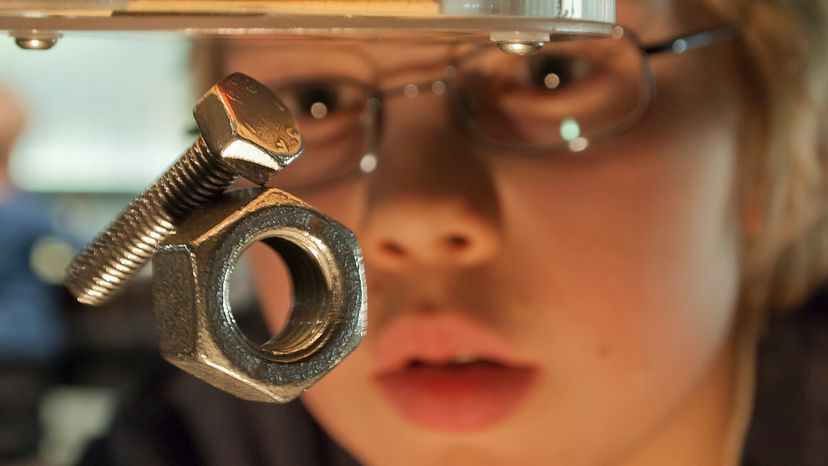Advertisem*nt
By: HowStuffWorks.com Contributors |Updated: Mar 31, 2021

Magnets have a wide range of uses, from sticking things to your refrigerator, to picking up metallic objects, to keeping cabinet doors closed. Some magnets can get weaker over time and no longer serve their purpose. Others are too weak for what we want them for to begin with. Unfortunately, there isn't always a way to make a magnet stronger. However there are a few ways to make some types of magnets stronger. Here's how to make certain magnets stronger:
- Iron bar magnets Fill a bowl or pan with some water. Find something that will float on the water. Lay the magnet on top of this object. The magnet will twirl in the water until it comes to rest pointing exactly north and south due to the magnetic force of the North Pole. Carefully take the magnet off the water and lay it on a hard (preferably wooden) surface in the exact same north-south position. Strike one end of the magnet hard with a hammer repeatedly. The force may loosen the tiny magnetic domains in the bar so they can point north like they are supposed to [source: Newton].
- Magnets that have lost their strength Sometimes you can recharge a magnet that has lost some of its original charge. If you can find a very strong magnet, repeatedly rub it across your weakened magnet. The strong magnet will realign the magnetic domains inside the weakened magnet [source: Luminaltech].
- Magnet stacking One way to make weak magnets stronger is by stacking more of them together. There's a big problem with this, though. Magnets attract each other in opposite directions, which will lower their overall strength. If you can find a way to hold or clamp them together, so they're aligned in the same direction, they will in fact produce a stronger magnetic field [source: Balbach].
Advertisem*nt
Magnet FAQs
What materials would make the strongest magnet?
The strongest magnets are made from an alloy of iron, boron, and neodymium.
How do magnets work?
Magnets have north and south poles that are attracted to each other. When an object is attracted to a magnet, it causes the the north-seeking poles of the atoms in the object to line up in the same direction. A magnetic field is created by the force generated by the aligned atoms. Thus, the object and the magnet bond.
How do you make a stronger magnet?
Place your weak magnet next to a much stronger magnet. This will realign the electrons in the weaker magnet. To do this, hit the weaker magnet with the larger, much stronger magnet.
What can magnets attract?
Magnets can attract metals such as iron and steel. In fact, if you rub a very strong magnet on a piece of iron or steel, that piece of metal will temporarily become a magnet. Copper and gold is also attracted to magnets.
Cite This!
Please copy/paste the following text to properly cite this HowStuffWorks.com article:
Citation
Advertisem*nt
Advertisem*nt
Loading...
\n\n\t\t\t\t
`;t.byline_authors_html&&(e+=`By: ${t.byline_authors_html}`),t.byline_authors_html&&t.byline_date_html&&(e+="|"),t.byline_date_html&&(e+=t.byline_date_html);var i=t.body_html.replaceAll('"pt','"pt'+t.id+"_");return e+=`\n\t\t\t\t
\n\t\t\t\t
\n\n\t\t\t\t
${i=i.replaceAll("#pt","#pt"+t.id+"_")}
\n\n\t\t\t
`}(a);this.loadedDiv.innerHTML+=n,document.title=a.title+" | HowStuffWorks";let s="content-loaded-"+a.id,l=document.getElementById(s);l.dataset.contentId=a.id;let o=l.querySelectorAll(".lazyload");HSW.utilities.lazyLoadElements(o),HSW.ux.editorial.init({twitter:!0,facebook:!0,instagram:!0}),l.querySelectorAll(".toc a").forEach(t=>{t.addEventListener("click",t=>{t.preventDefault();let e=t.target.dataset.target,i=document.querySelector("a[name='"+e+"']");i?i.scrollIntoView({behavior:"auto"}):console.error("Unable to locate target with name "+e)})});try{if(userData.adsActive)if(HSW.utilities.isMobile()){l.querySelectorAll(".ad-mobinline").forEach(t=>{t.setAttribute("id","ad-wrap-mobinline"+r),t.childNodes[0].setAttribute("id","ad-div-mobinline"+r),void 0!==HSW.ads&&HSW.pq.add(()=>{HSW.ads.addNewUnits(["ad-div-mobinline"+r])},"ads"),r++})}else{let t=document.createElement("div");t.setAttribute("id","ad-after-"+e),t.classList.add("ad-inline","mb-8","bg-gray","w-max-full","h-min-90","text-center");let a=document.createElement("div");a.setAttribute("id","ad-div-inline"+i),t.appendChild(a),l.after(t),void 0!==HSW.ads&&HSW.pq.add(()=>{HSW.ads.addNewUnits(["ad-div-inline"+i])},"ads")}}catch(t){console.error(t)}if(window.setupSinglePageUX(l),history.pushState)try{history.pushState(null,a.title+" | HowStuffWorks",a.href)}catch(t){console.warn(t)}var c=[];a.taxonomy.forEach((t,e)=>{c[e]=t.title.toLowerCase()});var d=c.join("/"),h=[];a.authors.forEach((t,e)=>{h[e]=t.first_name.toLowerCase()+" "+t.last_name.toLowerCase()});var g=h.join(",");pageMetricsData.href=a.href,pageMetricsData.title=a.title,pageMetricsData.tax=d,pageMetricsData.aType=a.asset_type,pageMetricsData.cType=a.type+"-continuous",pageMetricsData.template=a.template,pageMetricsData.source=a.source,pageMetricsData.sponsor=a.sponsor,pageMetricsData.author=g,pageMetricsData.contentid=a.id,pageMetricsData.image=a.hero_image,pageMetricsData.page=0,pageMetricsData.pubDate=a.publish_date.slice(0,10),pageMetricsData.editDate=a.last_editorial_date.slice(0,10);const u=/[^\da-z_]/i;let p=HSW.utilities.isMobile()?"hsw_lite":"hsw";a.taxonomy.slice(1,3).forEach((t,e)=>{p+="|"+t.title.replace(u,"").toLowerCase()}),pageMetricsData.adUnit=p,Alpine.store("share",{title:pageMetricsData.title,url:pageMetricsData.href,image:pageMetricsData.image}),function(t,e){let i=t.href.split(".com/").pop();dataLayer.push({event:"virtual-page-view",virtualPageUrl:i,virtualPageTitle:document.title,pageNbr:0}),dataLayer.push({event:"raw-event-interactive",eventCategory:"page-interaction",eventAction:"continuous-load",eventLabel:"new-content",eventValue:e+1,virtualPageUrl:t.href})}(a,this.items.length);const m={...pageMetricsData};t.items.push(m);for(var f=document.getElementsByClassName("new-content-loaded"),v=0;v
Advertisem*nt
Advertisem*nt
Advertisem*nt
Advertisem*nt
`;function adFill(){return{triggerElement:null,observer:null,isObserverPolyfilled:!1,nextIndex:0,maxIndex:30,disabled:!1,init(e){if("off"===HSW.utilities.hashArgs.ads)return;if("article-structured"==pageMetricsData.cType||HSW.utilities.isMobile()||!1===userData.adsActive)return;const t=this;this.triggerElement=document.querySelector("#continuous-ad-load-trigger"),this.nextIndex=e||this.nextIndex,"IntersectionObserver"in window&&"IntersectionObserverEntry"in window&&"isIntersecting"in window.IntersectionObserverEntry.prototype&&"intersectionRatio"in window.IntersectionObserverEntry.prototype?(this.observer=new IntersectionObserver(function(e){!0===e[0].isIntersecting&&t.getNextAd()},{rootMargin:"1000px 0px",threshold:.01}),this.observer.observe(this.triggerElement)):(this.isObserverPolyfilled=!0,window.alpineInfiniteRRScroll={scrollFunc(){var e=t.triggerElement.getBoundingClientRect();e.topAs an enthusiast deeply immersed in the realm of magnetism and its applications, I've explored the intricacies of magnets, from their fundamental principles to practical methods of manipulation. My fascination with magnets extends beyond the casual use on refrigerators; I've delved into the science behind magnetism, its various types, and how to enhance or restore their strength.
The article on HowStuffWorks provides valuable insights into maintaining and strengthening magnets. Let's break down the key concepts covered:
1. Methods to Strengthen Magnets:
a. Iron Bar Magnets:
- Fill a bowl with water and place a floating object.
- Lay the magnet on the object, allowing it to align north-south due to the magnetic force.
-
Remove the magnet, placing it on a hard surface, and strike one end with a hammer to potentially realign magnetic domains.
b. Recharging Weak Magnets:
-
If a magnet loses strength, rubbing it with a very strong magnet may realign magnetic domains inside the weakened magnet.
c. Magnet Stacking:
- Although stacking magnets can make them stronger, they typically attract each other in opposite directions, reducing overall strength.
- Aligning stacked magnets in the same direction and holding them together can produce a stronger magnetic field.
2. Materials for Strong Magnets:
- The strongest magnets are made from an alloy of iron, boron, and neodymium.
3. How Magnets Work:
- Magnets have north and south poles that attract each other.
- When an object is attracted to a magnet, it causes the north-seeking poles of the atoms in the object to align, creating a magnetic field that bonds the object and the magnet.
4. Making a Stronger Magnet:
- Place a weak magnet next to a much stronger magnet to realign the electrons in the weaker magnet by hitting it with the stronger one.
5. Materials Attracted by Magnets:
- Magnets can attract metals such as iron and steel. Additionally, copper and gold are also attracted to magnets.
In summary, the article covers practical methods for strengthening magnets, the materials that make the strongest magnets, the fundamental principles of magnetism, and the materials magnets can attract. This comprehensive understanding is crucial for anyone interested in harnessing the power of magnets for various applications.